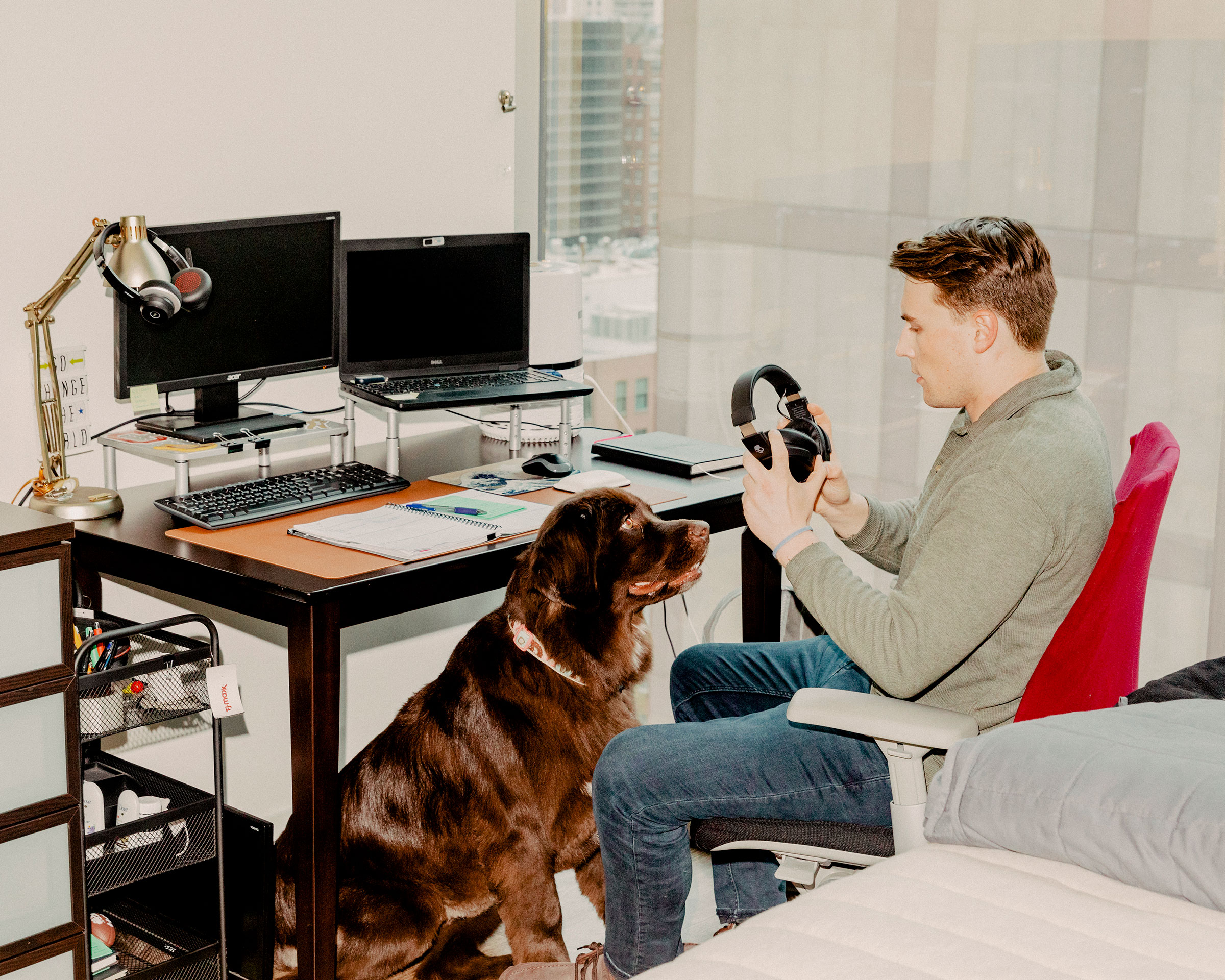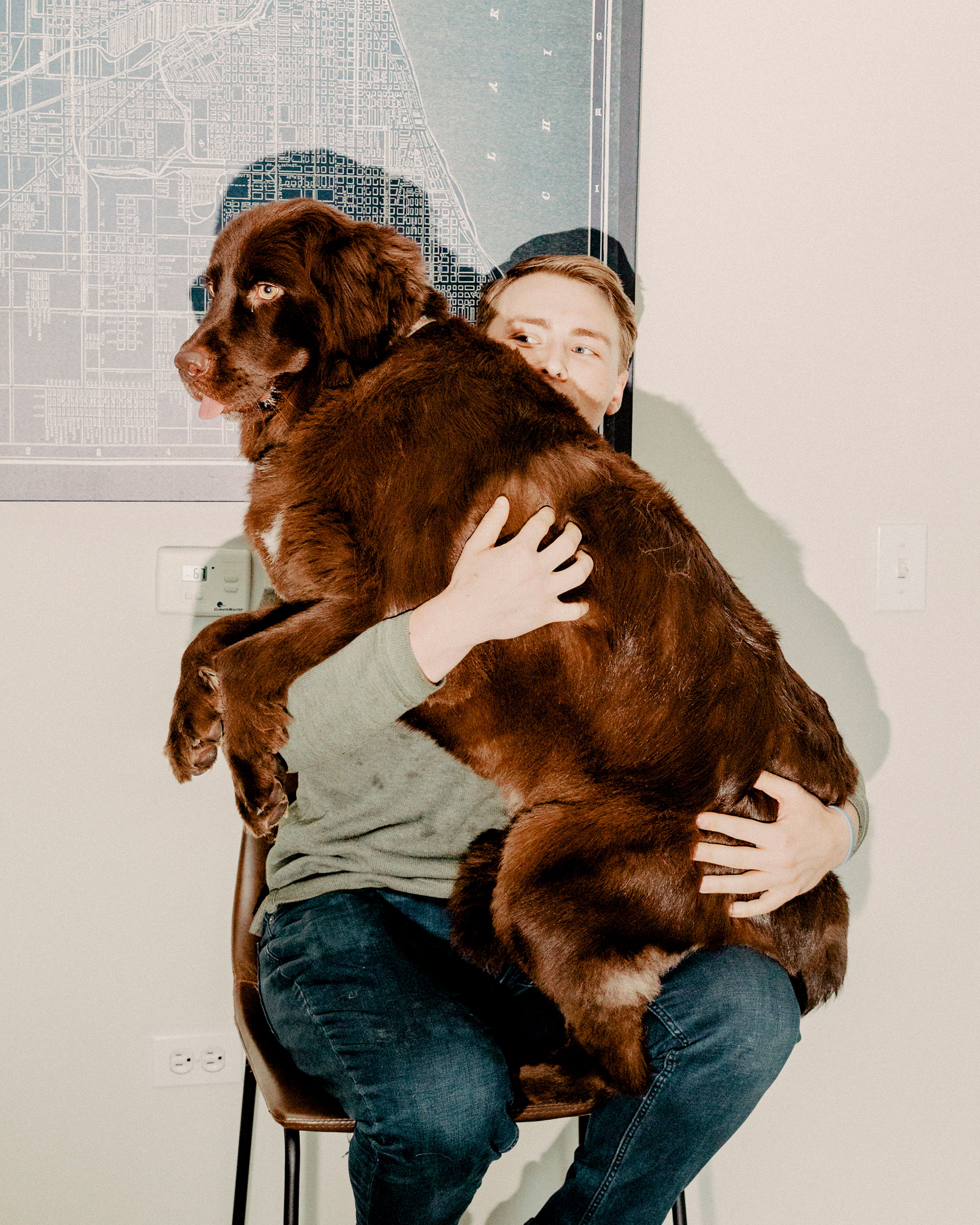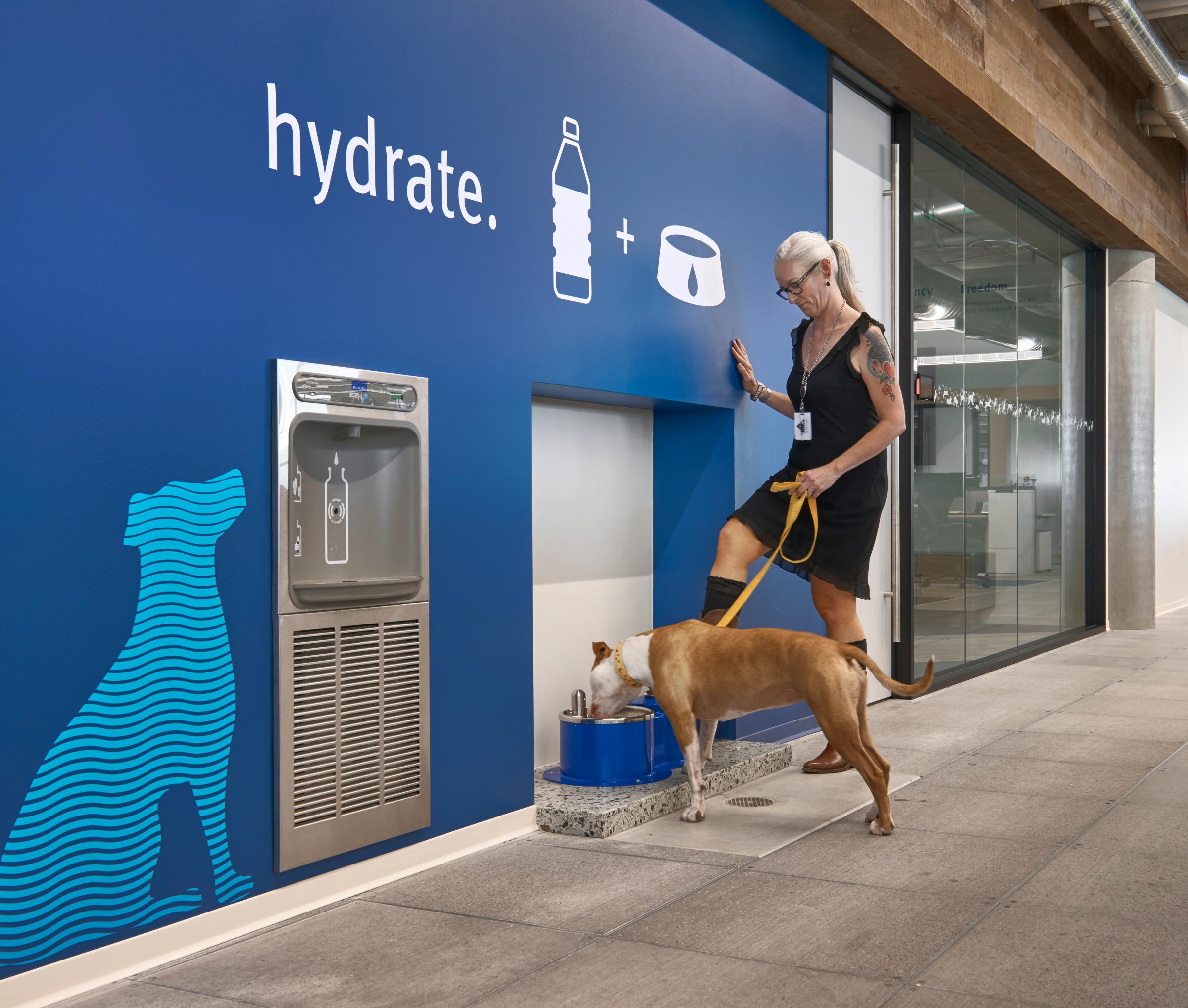
The subject line of the email from his employer was enough to whip Gus Azusenis into a frenzy. “UPDATE,” he read, a lump forming in his throat as he noted the urgency in all the capital letters. Then came the word he had been dreading for months: “RETURN.”
Even without reading the message, Azusenis knew what it would say—that after more than a year, employees at his Chicago bank would be going back to the office. Anxiety consumed the 24-year-old financial analyst as he tried to imagine how he could properly care for Finley, his pandemic puppy, if he had to leave her alone to work long hours, five days a week. “I went into sheer planning-for-disaster mode,” Azusenis says.
Across the room, blissfully unaware, Finley swished her tail back and forth, and Azusenis’ heart broke a little bit more. The year-old Newfoundland had essentially spent her entire life at home with him, and she had no clue their little bubble was about to burst. “I felt crushed,” Azusenis says.
He left the email unopened in a last-ditch effort to delay reality for one more day.
Read more: How the Pandemic Pet-Adoption Boom Fits Into the Long History of Rescuing Animals
As companies anticipating a post-pandemic U.S. look to reopen their offices, thousands of pet owners are experiencing similar moments of emotional turmoil. Poll after poll has shown that they’re worried about how returning to the office will impact their furry companions, particularly after the COVID-19 crisis created a surge in pet adoptions and situations in which many people rarely left their pets’ side. In the summer of 2020, a survey of 3,000 pet owners found that 1 in 5 worried their pets would have separation anxiety. In the spring of 2021, as vaccinations augured a return to normal life, another survey found this fear shared by 69%.
What’s more, of 400 dog owners surveyed by the pet-product company Honest Paws, 67% said they would consider looking for a different job if their company no longer offered remote work; 78% said they would stay if they could bring their pets to work. That sentiment is widely shared among young people, according to a separate Banfield Pet Hospital survey of 1,500 pet owners, which found that nearly half of Gen Zers, ages 18 to 24, and a third of millennials, 25 to 40, said they would rather quit their jobs than be forced to leave their pets at home alone full time.
Azusenis—who adopted Finley in March 2020—counts himself as one of them. The first-time dog owner used to prioritize his job above all else. But now he’s no longer willing to be chained to a desk for 12 hours, getting up only to use the bathroom or to bring back an apple, knowing Finley is waiting at home and depending on him for her every need. “Getting a dog has really made me question how I’m working, from now and beyond,” Azusenis says.
Clare Grindinger, 22, came to the same realization after a particularly busy day in March at the Dallas women’s shelter where she was working. Grindinger didn’t take her usual lunch break that day, so she wasn’t able to check in on Rumi, the 14-month-old mixed-breed pup she adopted in August 2020. When she returned home around midnight, Grindinger opened her front door to find Rumi sick and surrounded by vomit. “That’s a tough thing to come home to,” she says. “I didn’t know how sick he was.” Three months later, she left her job for a human-resources position with a major airline that lets her work from home permanently.
The ‘Planets Have Aligned’ for People and Pets
Banfield president Brian Garish says the survey results reflect his own newly developed anxieties about leaving his two young cats at home alone. His bond with Ashin and Kenji grew stronger as he worked from home and saw a new side to the 2-year-old felines. Garish learned, for instance, that Kenji could open doors, something the crafty cat did one day as Garish was delivering a presentation on Microsoft Teams. While Garish was mid-sentence, Kenji set off a security alert by opening the front door and walking out of the house. “I guess I always wondered what they did when I was at work, and now I know,” says Garish, who grabbed Kenji before he could go too far and then installed childproof locks on his doors.
As the economy recovers, employers nationwide are struggling to retain and recruit good workers, according to human-resources and labor experts as well as a handful of company executives interviewed by TIME. That’s giving millions of employees more bargaining power to “call the shots,” says Rue Dooley, an adviser with the Society for Human Resource Management (SHRM), a national trade group. “All the planets have aligned in such a way that employers now are fighting for the best talent,” Dooley says.
Among the top worker demands are pet-friendly policies, whether lenient work-from-home rules or permission to bring pets into the office.
Some 12.6 million U.S. households got a new pet after the World Health Organization declared the COVID-19 outbreak a pandemic in March 2020, according to the American Pet Products Association. A tally by the nonprofit Shelter Animals Count found that at least 269,000 pets were adopted from rescue groups alone in 2020, some 36,000 more than the year before.
The risks are too variable and too manifold. Just because it's good for the employees doesn't mean it's best for the organization.
Now, companies are searching for solutions that make both workers and pets happy. In Banfield’s survey of 500 C-suite executives, half said they planned to start allowing pets in the workplace, joining major companies like Google, Amazon and Ben & Jerry’s, which have long touted their pet-friendly corporate spaces. At least 59% of the executives surveyed said they were implementing new pet-friendly policies because of employee requests.
In December 2020, PuppySpot, a company that connects vetted dog breeders with prospective buyers, broke its lease at its main West Hollywood, Fla., headquarters about two years early to move to a Jersey City, N.J., building that allows pets. It was a costly decision, but one that could not wait as half of prospective new hires were asking whether the office was pet-friendly, says Jonathan Cherins, the company’s CEO. Being able to finally say yes was a “huge win” for PuppySpot’s credibility as an animal-loving organization as well as to recruitment efforts, Cherins says. “The ability to bring a dog to work is a real tangible piece of compensation,” he says, adding that the Florida workers are now entirely remote.
At Animalso, a pet-care blog site, morale and productivity improved as soon as a handful of dogs and cats started appearing in the office for the first time in June 2020, according to Rachel Cassidy, a veterinarian consultant at the website. At the company’s tiny West Covina, Calif., headquarters, lint rollers are available at every cubicle, and dogs can often be found chasing the newly purchased robot vacuum that works overtime to suck up mounds of fur. There’s even talk of creating tiny uniforms to match their owners’ company hoodies. “Pets are so much an extension of us that it just makes sense for them to follow us to work instead of being bored at home,” Cassidy says. “It sometimes makes us ask the question: Why didn’t we think of this sooner?”

Getting a dog has really made me question how I'm working, from now and beyond.
If it took two pro-pet companies a shakeup from a global pandemic to ask that question, it’s no wonder most U.S. companies still have not rolled out the red carpet for the four-legged. Despite the benefits and the huge concern of workers who became pet parents in the pandemic, only about 11% of U.S. workplaces allow pets, according to SHRM statistics from 2019, the most recent year with available data. There are countless reasons why. For one, thorny insurance, liability and workers’ compensation issues come into play if a dog bites another dog or, worse, a human colleague. In other instances, one person’s office dog can end up being another person’s nightmare if they’re allergic, fearful of dogs or easily annoyed by barking. “The risks are too variable and too manifold,” Dooley says. “Just because it’s good for the employees doesn’t mean it’s best for the organization.”
Still, the number of pet-friendly workplaces has been slowly increasing for years. The growth, though small, has been promising for pet lovers—the 2019 figure is more than double the percentage in 2013. If there was ever a moment for widespread change, it’s now, says Dooley, who predicts a massive spike in pet-friendly offices in 2021. Pre-pandemic, few companies were paying attention to the value of pets, even though industry data shows pet owners collectively pour billions of dollars a year into caring for their critters. But now, pets are at the forefront, and it seems that changing office infrastructures and a more empathetic society are paving the way for their inclusion in the workplace, Dooley says.
For one, many companies have implemented hybrid telecommuting work schedules or staggered in-person hours, meaning fewer people in the office and thus a more accommodating environment to introduce four-legged office mates. To keep germs at bay during the pandemic, many workplaces put up plexiglass barriers to isolate individual cubicles, which can double as pet-friendly pens.
The ability to bring a dog to work is a real tangible piece of compensation.
That’s similar to how Ben & Jerry’s has been able to successfully integrate dogs in its large Vermont headquarters, where there are free dog treats at the reception desk and complimentary doggy ice cream. Each dog owner’s cubicle is enclosed with a baby gate, and each workspace features a mini plush sofa for a pooch. Pre-pandemic, the ice cream giant would host up to 40 dogs at a time. This year, Lindsay Bumps, Ben & Jerry’s global marketing specialist, anticipates that even more new canines will join the corporate family once the office reopens sometime in the fall. “Dogs have been a source of emotional support throughout quarantine times,” says Bumps, adding that she would not accept a job unless she was allowed to bring Spock, her 9-year-old French bulldog, to work.
Mental Health Concerns
That mental-health boost is the catalyst the pets-at-work movement might need to gain momentum. The moment comes after more than 15 months of darkness from a global pandemic that killed more than 600,000 people in the U.S., led to increased isolation and brought a slew of mental-health issues, including depression. Before Azusenis adopted Finley, he was living by himself and feeling increasingly lonely. Finley gave him something to focus on, he says, and he poured all of himself into making sure his dog’s finite time on earth was filled with happiness. “I felt like throughout this last year, I was wandering through a field in the dead of night, in pitch black,” he says. “She kept me focused on the light.”

For Cherins, the PuppySpot CEO, it was urgent after so much trauma that he break his headquarter’s lease to ensure workers had a warm and friendly environment to return to. Dooley agrees, saying pets have the power to soften even the hardest hearts, especially after prolonged suffering. “We’re increasingly afraid of each other, angry with each other, annoyed with each other, for no reason whatsoever,” he says. “We need more sweetness.”
People like Kristen Aikey are depending on it. Aikey, 23, is the primary caretaker of Penny, her family’s 15-year-old dachshund, who became blind last summer due to glaucoma. Aikey has been administering three different eye drops four times a day, along with eye ointment and thyroid pills twice daily. Her responsibilities begin as early as 4 a.m.—when Penny wakes up to relieve herself and takes her first dose of medication—and continue every few hours until bedtime.
Read more: Pets Are Part of Our Families. Now They’re Part of Our Divorces, Too
Aikey has been working remotely for a Manhattan-based public relations company, but she and her parents, who have returned to the office, worry how they’ll care for Penny if Aikey can no longer be the designated work-from-home steward. Their biggest fear is that Penny will fall down any of the three sets of stairs in the house when nobody is home. But they’re also worried how their senior pet will react to being left alone in general.
“That would be a culture shock for her, right after a full year of having all the attention,” says Aikey, who has vivid memories of the day her family bought Penny from a pet store in 2005, even though she was only in second grade. There was a discount on the 5-month-old wiener dog, who was wearing a pink bow and whose head was covered in little bumps from constantly whacking it against the water bottle in her cage. Aikey was “obsessed” with Penny from the start, and they’ve only grown closer since 2020. “It’s been the ‘Kristen-and-Penny Show’ for the last full year,” Aikey says. “How can you rip that away?”
Perhaps no one understands this better than Azusenis. In Chicago, when Azusenis was ready to face reality on June 2—some 24 hours after the work email landed in his inbox—he finally read the message, and it confirmed his fears. His employer was strongly encouraging all workers to return to the office, where pets are prohibited, starting June 14. His heart racing, Azusenis called his mother back home in Cleveland for parenting advice. From 300 miles away, she first tried to reassure him that everything would be O.K., but reminded him that he’d known this would happen eventually.
On the morning of June 14, Azusenis could not get himself to put on a suit and tie and leave home. Instead, he signed on from home and hoped for the best—his strategy to this day. For now, there’s been no disciplinary action for not returning to the office, and the company’s request is merely a “strong suggestion,” Azusenis says. He doubts his situation is sustainable in the long run, but he would rather take the risk than be separated from Finley.
“Neither of us really knows what that’s like,” he says. “Isn’t that right, Finley?”
In his office-bedroom, the bearlike puppy was nestled near him fast asleep, still blissfully unaware.
More Must-Reads From TIME
- The 100 Most Influential People of 2024
- Coco Gauff Is Playing for Herself Now
- Scenes From Pro-Palestinian Encampments Across U.S. Universities
- 6 Compliments That Land Every Time
- If You're Dating Right Now , You're Brave: Column
- The AI That Could Heal a Divided Internet
- Fallout Is a Brilliant Model for the Future of Video Game Adaptations
- Want Weekly Recs on What to Watch, Read, and More? Sign Up for Worth Your Time
Contact us at letters@time.com